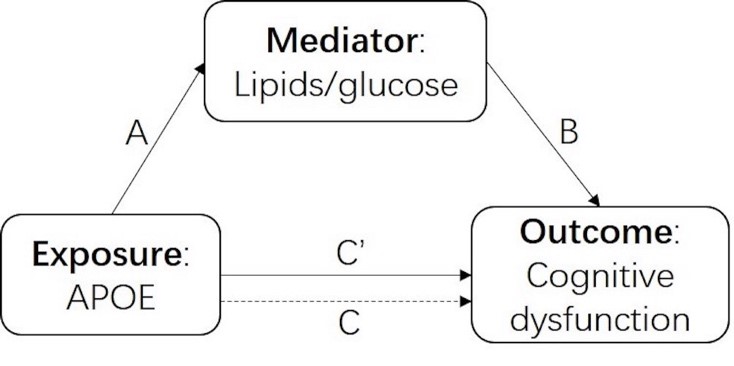阿尔茨海默症(Alzheimer’s Disease,AD),是最常见的一类老年痴呆。作为一种起病隐匿的进行性发展的神经系统退行性疾病,其病因尚不明确且缺乏有效治疗药物,发病风险随着年龄增长而升高,发病进程常持续数年,因此伴随着社会老龄化的加深,阿尔茨海默症会越来越常见,如何预防和减缓认知功能下降将是健康老龄化的重要挑战。
关于认知功能的风险因素,载脂蛋白E基因(APOE)是迄今为止认知障碍和阿尔茨海默症(AD)公认的最重要的遗传风险因素,但基因作用的相关机制及其与环境的相互作用尚有待探索。
清华大学万科公共卫生与健康学院副教授John S. Ji(纪思翰)团队及其合作者团队针对这一问题进行了相关研究:(1)分析APOE与脂质、血糖代谢之间的关系;(2)分析包含APOE的多基因风险评分与住宅绿化度之间的交互作用;(3)分析APOE基因和生活方式对认知功能的共同影响。研究结果于今年分别发表在Frontiers in Aging Neuroscience,Science of the Total Environment,PLOS Medicine杂志上。
研究发现APOE ε2基因型对认知功能有直接的保护作用,但与此同时,其与总胆固醇降低有关,而在我们的老年调查对象中,异常的脂质或血糖水平与认知功能障碍并非始终相关,低总胆固醇水平反而有更高的认知功能障碍风险。另外APOE ε4基因型对LDL-C(低密度脂蛋白胆固醇)低水平的人群的认知功能产生有害影响,而对LDL-C高水平人群无显著影响。这些发现表明APOE、胆固醇、血糖和认知功能之间存在复杂的关系。

图. 基因,脂质/血糖及认知功能的关联假设
通过分析多基因风险评分与住宅绿化的交互作用,我们发现与AD低基因风险的调查参与者相比,AD高基因风险的参与者认知障碍的发生比要高44%。与居住在低绿化度地区的参与者相比,居住在高绿化度地区参与者的认知障碍发生比要低 33%。同时,在AD低基因风险评分的人群中,高住宅绿化度有利于降低认知障碍风险,而在AD基因风险较高的人群中,我们没有观察到绿化对认知障碍存在保护作用,即绿化和认知障碍之间的关联仅在AD低基因风险的人群中显著。
图. 绿化对认知功能的保护作用在低基因风险人群中更显著
通过对参与者的吸烟、喝酒、锻炼及饮食习惯打分,将他们的生活方式分为“健康”、“一般”、“不健康”三类生活方式。健康的生活方式有助于减少认知障碍的发生,而这一作用在AD高风险基因APOE ε4的携带者和非携带者中无显著差异。
AD的遗传风险在整个生命过程中会进行累积,并且在高龄时更难降低。关于住宅绿化是否可以改变 AD遗传风险的证据对健康老龄化以及预防 AD和痴呆症具有重要意义。据统计,在中国,高龄老人(80 岁以上)是增长最快的人群,认知功能障碍是这一年龄组中一个急剧增长的公共卫生问题,在许多其他低收入和中等收入国家(LMIC)也存在着这样的问题。因此,我们的研究可能对预防这些中低收入国家的高龄人群认知障碍有一定意义。目前仍需要来自更大的队列和其他人群中的验证证据。如果得到证实,则有必要对以上基因风险,环境暴露及生物标志物水平综合分析,制定个性化干预,预防痴呆症和阿尔茨海默症。
Apolipoprotein E Induced Cognitive Dysfunction :
Mediation Analysis of Lipids and Glucose Biomarkers in an Elderly Cohort Study
Introduction:
Prior evidence suggested Apolipoprotein E (APOE), lipids, and glucose metabolism may act through the same pathways on the pathogenesis of Alzheimer’s disease (AD).
Methods:
This prospective study used data from the Chinese Longitudinal Healthy Longevity Study. We tested the associations of APOE genotype (ε2ε2, ε2ε3, ε2ε4,ε3ε3, ε3ε4, and ε4ε4) and cognitive function using generalized estimating equations (GEE). We examined for possible mediation and effect modification by lipids and glucose level in this association.
Results:
APOE ε2 showed significant direct protective effect and indirect harmful effect through TC on cognitive function. Abnormal lipids or glucose levels were not consistently associated with cognitive dysfunction in our study. We did not detect significant indirect effects through lipids for APOE ε4 or any indirect effect sthrough glucose.
Discussion:
These findings suggested complicated relationships among APOE, lipids, glucose,and cognitive function. Further study can make validations in other populations.
Interaction of greenness and polygenic risk score of Alzheimer’s disease on risk of cognitive impairment.
Introduction:
Studies have shown contact with nature has positive psychological, neurological, and cognitive benefits. Whether the built environment can affectgenetic predisposition of Alzheimer's disease (AD) should be explored. We aimed to examine whether greenness around the residential environment can modify the effect of genetic AD risk on cognitive function.
Methods:
We used a genetic sub-study of the Chinese Longitudinal Healthy Longevity Survey including 1199 older adults (mean age: 100.3 ± 3.4 years) aged 90 years old or older. We used Polygenic Risk Score (PRS) to quantify the genetic AD risk and two types of measurements based on Normalized Difference VegetationIndex (NDVI) to access the residential greenness (contemporaneous and annualaverage NDVI). Contemporaneous NDVI values were the NDVI value collected at the corresponding survey, and the annual average NDVI was the average value of NDVIduring the year before the corresponding survey. We defined cognitive impairment as having a Mini-Mental State Examination score below 25.
Results:
Inthe multivariable logistics regression models, contemporaneous NDVI and geneticAD risk were associated with cognitive impairment. Among those with low geneticAD risk, the risk of cognitive impairment was lower in those living around higher greenness (contemporaneous NDVI OR: 0.55, 95% CI: [0.34, 0.86]; Pinteraction:0.071; annual average NDVI OR: 0.49, 95%CI:[0.31, 0.79]; Pinteraction: 0.040). We did not observe significant associations between greenness and cognitive impairment among thosewith high genetic AD risk.
Conclusion:
Prevention efforts using PRS warrant a higher granularity of environmental exposures and biological etiology data.
Association of APOE ε4 genotype and lifestyle with cognitive function among Chinese adults aged 80 years and older: A cross-sectional study
Background:
Apolipoprotein E (APOE) ε4 is the single most important genetic risk factor for cognitiveimpairment and Alzheimer disease (AD), while lifestyle factors such as smoking, drinking, diet, and physical activity also have impact on cognition. The goal of the study is to investigate whether the association between lifestyle and cognition varies by APOE genotype among the oldest old.
Methods and findings:
We used the cross-sectional data including 6,160 oldest old (aged 80 years old orolder) from the genetic substudy of the Chinese Longitudinal Healthy Longevity Survey (CLHLS) which is a national wide cohort study that began in 1998 with follow-up surveys every 2-3 years. Cognitive impairment was defined as a Mini-Mental State Examination (MMSE) score less than 18. Healthy lifestyle profile was classified into 3 groups by a composite measure including smoking, alcohol consumption, dietary pattern, physical activity, and body weight. APOE genotype was categorized as APOE ε4 carriers versus noncarriers. We examined the associations of cognitive impairment with lifestyle profile and APOE genotype using multivariable logistic regressions, controlling for age, sex, education, marital status, residence, disability, and numbers of chronicconditions. The mean age of our study sample was 90.1 (standard deviation [SD],7.2) years (range 80-113); 57.6% were women, and 17.5% were APOE ε4 carriers.The mean MMSE score was 21.4 (SD: 9.2), and 25.0% had cognitive impairment. Compared with those with an unhealthy lifestyle, participants with intermediateand healthy lifestyle profiles were associated with 28% (95% confidenceinterval [CI]: 16%-38%, P < 0.001) and 55% (95% CI: 44%-64%, P < 0.001) lower adjusted odds of cognitive impairment. Carrying the APOE ε4 allele was associated with 17% higher odds (95% CI: 1%-31%, P = 0.042) of being cognitively impaired in the adjusted model. The association between lifestyle profiles and cognitive function did not vary significantly by APOE ε4 genotype(noncarriers: 0.47 [0.37-0.60] healthy versus unhealthy; carriers: 0.33[0.18-0.58], P for interaction = 0.30). The main limitation was the lifestyle measurements were self-reported and were nonspecific. Generalizability of the findings is another limitation because the study sample was from the oldest old in China, with unique characteristics such as low body weight compared to populations in high-income countries.
Conclusions:
In this study, we observed that healthier lifestyle was associated with better cognitive function among the oldest old regardless of APOE genotype. Our findings may inform the cognitive outlook for those oldest old with high genetic risk of cognitive impairment.
1. Liu L, Li H, Iyer H,Liu AJ, Zeng Y, Ji JS. Apolipoprotein E Induced Cognitive Dysfunction :Mediation Analysis of Lipids and Glucose Biomarkers in an Elderly Cohort Study. Frontiers in Aging Neuroscience 2021;13:1–11.
2. Jin X,Shu C, Zeng Y, Liang L, Ji JS. Interaction of greenness and polygenic risk scoreof Alzheimer’s disease on risk of cognitive impairment. Science of the Total Environment 2021;796:148767.
3. Jin X, He W, Zhang Y,Gong E, Niu Z, Ji JS, Li Y, Zeng Y, Yan LL. Association of APOE ε4 genotype andlifestyle with cognitive function among Chinese adults aged 80 years and older: A cross-sectional study. PLoS Medicine 2021;18(6):1–18.